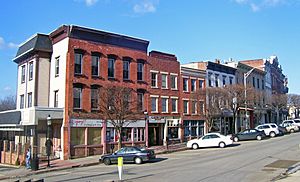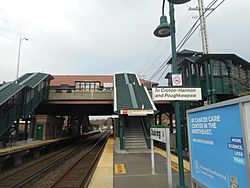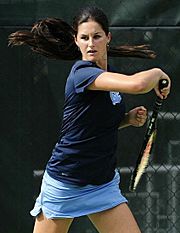Ossining (village), New York facts for kids
Quick facts for kids
Ossining, New York
Sing Sing
|
|
|---|---|

|
|

Location of Ossining (village), New York
|
|
| Country | United States |
| State | New York |
| Region | Hudson Valley |
| County | Westchester |
| Town | Ossining |
| Incorporated | 1813 |
| Government | |
| • Type | Council–manager |
| Area | |
| • Total | 6.3 sq mi (16.4 km2) |
| • Land | 3.2 sq mi (8.3 km2) |
| • Water | 3.1 sq mi (8.1 km2) |
| Elevation | 161 ft (49 m) |
| Population
(2010)
|
|
| • Total | 25,060 |
| • Estimate
(2019)
|
24,812 |
| • Demonym | Ossinaut |
| Time zone | UTC−5 (Eastern (EST)) |
| • Summer (DST) | UTC−4 (EDT) |
| ZIP Code |
10562
|
| Area code(s) | 914 |
| FIPS code | 36-55530 |
| GNIS feature ID | 0959520 |
Ossining is a village in Westchester County, New York, United States. The population was 25,060 at the 2010 census. As a village, it is located in the town of Ossining.
Contents
Geography
Ossining borders the eastern shores of the widest part of the Hudson River.
According to the United States Census Bureau, the village has a total area of 6.3 square miles (16.4 km2), of which, 3.2 square miles (8.3 km2) of it is land and 3.1 square miles (8.1 km2) of it (49.37%) is water.
Demographics
| Historical population | |||
|---|---|---|---|
| Census | Pop. | %± | |
| 1860 | 5,345 | — | |
| 1870 | 4,696 | −12.1% | |
| 1880 | 6,578 | 40.1% | |
| 1890 | 9,352 | 42.2% | |
| 1900 | 7,939 | −15.1% | |
| 1910 | 11,480 | 44.6% | |
| 1920 | 10,739 | −6.5% | |
| 1930 | 15,241 | 41.9% | |
| 1940 | 15,996 | 5.0% | |
| 1950 | 16,098 | 0.6% | |
| 1960 | 18,662 | 15.9% | |
| 1970 | 21,659 | 16.1% | |
| 1980 | 20,196 | −6.8% | |
| 1990 | 22,582 | 11.8% | |
| 2000 | 24,010 | 6.3% | |
| 2010 | 25,060 | 4.4% | |
| 2019 (est.) | 24,812 | −1.0% | |
| U.S. Decennial Census | |||
As of the 2010 United States Census, there were 25,060 people living in the village. The racial makeup of the village was 61.8% White, 15.6% Black, 0.1% Native American, 4.2% Asian, <0.1% Pacific Islander, 0.4% from some other race and 1.3% from two or more races. 41.4% were Hispanic or Latino of any race.
As of the census of 2000, there were 24,010 people, 8,227 households, and 5,339 families living in the village. The population density was 7,464.8 people per square mile (2,879.0/km2). There were 8,515 housing units at an average density of 2,647.4 per square mile (1,021.0/km2). The racial makeup of the village was 60.5% White, 20.2% Black or African American, 0.2% Native American, 4.2% Asian, 0.0% Pacific Islander, 10.4% from other races, and 4.2% from two or more races. Hispanic or Latino of any race were 27.7% of the population.
There were 8,227 households, out of which 30.7% had children under the age of 18 living with them, 47.0% were married couples living together, 12.9% had a female householder with no husband present, and 35.1% were non-families. Of all households 28.9% were made up of individuals, and 9.6% had someone living alone who was 65 years of age or older. The average household size was 2.61 and the average family size was 3.17.
In the village, the population was spread out, with 20.7% under the age of 18, 8.3% from 18 to 24, 39.1% from 25 to 44, 20.9% from 45 to 64, and 11.0% who were 65 years of age or older. The median age was 36 years. For every 100 females, there were 117.6 males. For every 100 females age 18 and over, there were 119.4 males.
The median income for a household in the village was $52,185, and the median income for a family was $60,179. Males had a median income of $40,412 versus $36,975 for females. The per capita income for the village was $25,036. About 7.6% of families and 10.6% of the population were below the poverty line, including 12.9% of those under age 18 and 8.3% of those age 65 or over.
History
Frederick Philipse bought the area which presently constitutes the Town of Ossining from the Sint Sinck Indians in 1685. The Sint Sinck are members of the Matinecock (Algonquin) tribe, who originally resided in the area of Cow Neck Peninsula on Long Island, New York. His Manor extended from Spuyten Duyvil Creek on the border between present day Manhattan and the Bronx to the Croton River. The last Lord of the Manor, Frederick III, was a Loyalist in the American Revolutionary War who fled to England, so the State of New York confiscated the manor in 1779.
In 1838 Benjamin Brandreth built a manufacturing facility for his Vegetable Universal Pills which became one of the most successful patent medicines in the United States. Brandreth's business became very successful and his firm was at one point the nation's leading proprietary advertiser. Brandreth became President of the village for many years.
Due to the history of the village, a number of Ossining structures are on the National Register of Historic Places, and the downtown shopping area is listed as the Downtown Ossining Historic District. In addition, the Sparta neighborhood has been designated a local historic district. Ossining’s role in New York’s heritage has been recognized by its inclusion, as one of only 14 areas, in an Urban Cultural Park System designed to attract visitors to the State. Also listed on the National Register of Historic Places are the Richard Austin House, Brandreth Pill Factory, First Baptist Church of Ossining, Highland Cottage, St. Paul's Episcopal Church and Rectory, and Washington School.
Name
Until 1901, the village was known as Sing Sing. It changed its name to avoid the stigma of association with Sing Sing Correctional Facility, which is still, by far, Ossining's largest employer.
Transportation

The Ossining train station provides commuter rail service to Grand Central Terminal in New York City or Croton-Harmon and Poughkeepsie via the Metro-North Railroad's Hudson Line. The Bee-Line Bus System provides bus service to Ossining on routes 11, 13, 14, and 19. NY Waterway also operates a ferry between Ossining and Haverstraw in Rockland County during the rush hours.
No interstate highways exist within Ossining. The closest example of a federal highway that runs through the village is US 9, along Highland Avenue and Albany Post Road. NY 133 begins at US 9, running along Croton Avenue, and NY 134 begins at that road along Dale Avenue. Part of NY 9A, along the Briarcliff–Peekskill Parkway runs through the eastern edge of the village.
Notable people
- Henry Campbell Black, author Black's Law Dictionary; born 1860.
- Edmund March Blunt, navigator and publisher, lived in Ossining.
- Ken Buck, United States Representative, born in Ossining.
- Robert Byrne, grandmaster of chess.
- John Cheever, writer and winner of the 1979 Pulitzer Prize for Fiction, lived in Ossining from 1961 until his death in 1982.
- Nick DiPaolo, comedian, known for Tough Crowd.
- Peter Falk, actor, attended Ossining High School.
- Anne Francis, actress, born in Ossining.
- Jamie Loeb (born 1995), tennis player.
- Raven-Symoné, actress.
- Jesse Lee Soffer, (actor) born in Ossining; best known as Det Jay Halstead on Chicago PD, Med, and Fire.
- Obi Toppin, Basketball player, Went to the University of Dayton and won National Player of the Year in 2020.
- Stefan Zweig, Austrian writer, lived briefly in Ossining and completed his autobiography there in 1941.
In fiction
In seasons 1–3 of AMC's TV series Mad Men, Ossining is home to lead character Don Draper and his family. It remains the home of his ex-wife, Betty, and their children through much of season 4, until they move to Rye.
In FX's The Shield, transfer to Ossining is offered to an inmate in exchange for testimony, stated as "Safe and sound in Ossining, New York" as opposed to referencing the town's original name of Sing Sing which might have jeopardized the deal.
Twin cities
 Sassinoro, Italy
Sassinoro, Italy
Education
Ossining has several public schools, operated by Ossining Union Free School District, and three nearby parochial schools. In 2000, Ossining High School was among the United States' highest performing schools.
Ossining has two nearby college campuses. A Westchester Community College campus exists in Ossining; in nearby Briarcliff Manor, there is also a Pace University campus.
Ossining Public Library
The Ossining Public Library, originally chartered in 1893 as the Sing Sing Public Library, serves the residents of the Village and Town of Ossining. The current library collections include 110,000 books, 25,000 non-print items, and 300 newspaper and magazine titles. As a charter member of the 38-member Westchester Library System, the Ossining Public Library offers its patrons access to the more than one million holdings of the other county libraries. A $15.8-million building program was started in 2005 to replace the 1960s-era facility with a new 48,000-square-foot (4,500 m2) building. The new Ossining Public Library opened in March 2007 and added many new or enhanced services, including over 50 public Internet terminals, a 250-seat theater, an art gallery, and the county's first radio frequency (RFID) circulation system.
The main reading room of Ossining's library is named in honor of longtime Ossining resident, Pulitzer Prize–winning author John Cheever. When Cheever died, the flags on Ossining's public buildings were lowered for 10 days.
See also
 In Spanish: Ossining (villa) para niños
In Spanish: Ossining (villa) para niños


